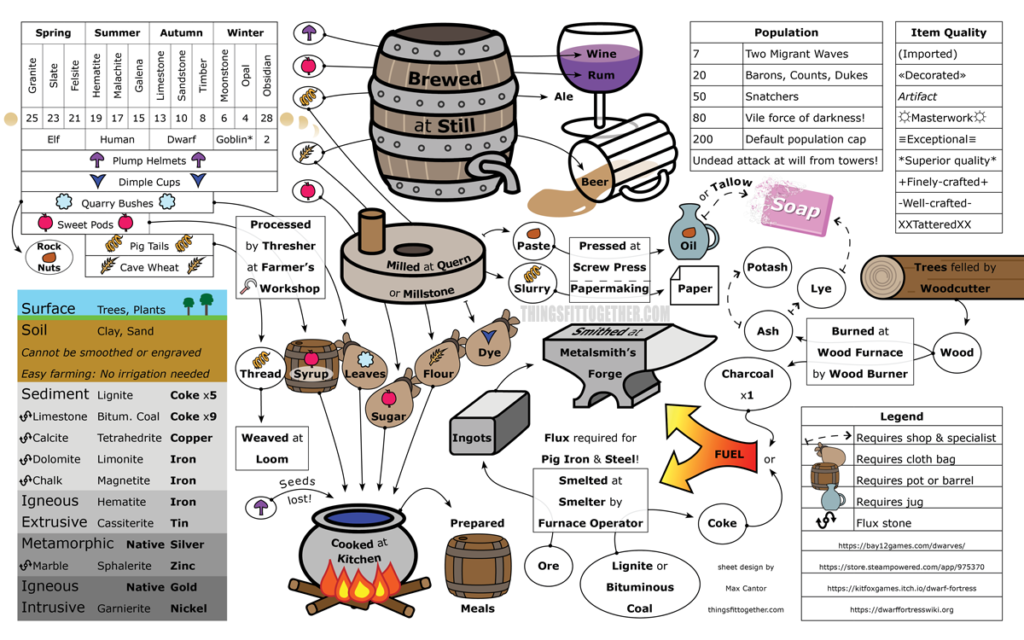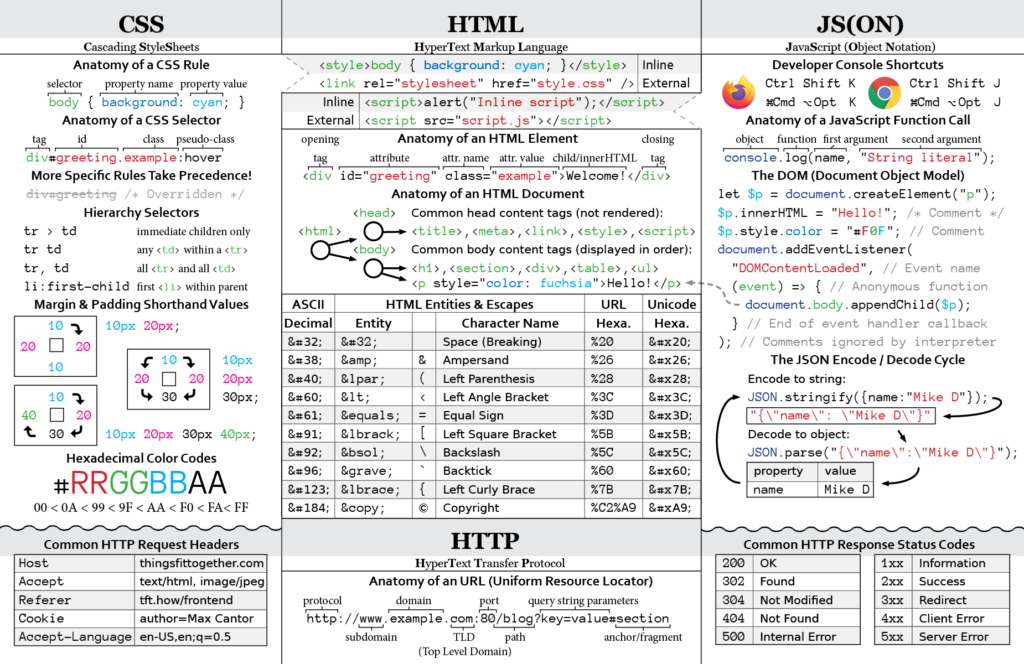
Crop Calendar
The upper-left of the sheet is a calendar of which crops will grow in which seasons. By row:
- The season names
- The months of the Dwarven calendar, from Granite to Obsidian
- The dates of the full moon in each month. Obsidian has two full moons, on the 28th and the 2nd. There is no particular reason for the inclusion of this information…
- The trade caravan that appears each month. You are not guaranteed to see any particular caravan; it depends on which civilizations are near to your fortress. The Goblin caravan is denoted with an asterisk because most of the time, Dwarven civilizations will be at war with Goblin civilizations. But if you somehow manage to make peace with them, the Goblins will trade with you over the Winter.
- The crops:
- Plump helmets, the iconic mushrooms which grow year-round and can be brewed into Dwarven wine or cooked into a meal. Beware of allowing your cooks to use plump helmets as ingredients, because cooking does not produce seeds, which could leave you bereft of plump helmet seeds until the next caravan.
- Dimple cups, another year-round crop which so far have only one use, being ground into dye. Thread, yarn, and cloth can be dyed at a dyer’s workshop. (Finished garments cannot be dyed)
- Quarry bushes, which grow from spring to autumn and can be processed intoi leaves for cooking. Quarry bushes are unique in that their seeds have a special name other than “plant + seed”: they are called “rock nuts”, and they can be pressed into oil, which can be cooked or combined with lye to create soap.
- Sweet pods, which have a wide variety of uses: They can be processed into barrels of syrup, milled into Dwarven sugar, or brewed into Dwarven rum. They only grow in the Spring and Summer.
- Pig tails, a textile crop that can be processed into thread for cloth, milled into slurry for papermaking, or brewed into Dwarven ale. Pig tails are a late-year crop, growing in Autumn and Winter. This gives you plenty of time to get your basic food industry running with plump helmets, quarry bushes, and sweet pods before it’s time to think about textile industry with pig tails.
- Cave wheat, which can be milled into flour or brewed into Dwarven beer. Cave wheat, like pig tails, only grows in the Autumn and Winter, and can provide some nice variety if your dorfs are tired of drinking plump helmet wine all year.
Surface and Ores Chart
Proceeding counterclockwise down the design, you will find the surface and ores chart. Importantly, it notes that soil cannot be smoothed or engraved, which makes it a poor choice for most of your fortress, since dorfs like to see smooth walls full of engravings of their lives and Dwarven history. However, it is easy to farm in soil, because it does not need to be irrigated with water to produce mud first, like stone. You will also find that soil is much faster to mine than stone, and it never leaves behind chunks of rock.
Proceeding downward in depth, the chart notes some important features for the stone layers:
- The sedimentary layer contains a lot of flux stones (limestone, dolomite, chalk, and calcite, which appears within limestone layers), and the best sources for fuel in the game, lignite and bituminous coal. You’ll also find the necessary ores for copper (tetrahedrite) and iron (limonite and magnetite), which are important for smithing weapons and armor. Sedimentary layers can also encompass alluvial layers, which can contain native gold, native platinum, and cassiterite.
- The igneous extrusive layer is another place you are likely to find cassiterite, the only ore of tin, which can be alloyed with copper to create bronze. Igneous extrusive layers also contain hematite, another ore of iron, and native copper.
- In metamorphic layers, you’ll find the remaining flux stone, marble, as well as native silver (in gneiss layers), galena (an ore of lead and silver), and sphalerite, the only ore of zinc, which can be alloyed into brass.
- The igneous intrusive layer is the only layer to include gabbro, which contains diamonds, and garnierite, the only ore of nickel. Some other metals may show up, such as cassiterite, galena, and bismuthinite, the only ore of bismuth.
Population and Item Quality
In the top-right of the sheet are the population threshold and item quality tables. The former describes the different population thresholds at which certain events become possible: at 50 dorfs, you might want to post some sentries or guard dogs to protect the children from snatchers. Once you reach 80 population, the fortress is at risk of siege (if there are nearby warring civilizations). The undead? Oh, don’t worry about them. Necromancers are just a scary story dorfs tell their children to keep them out of the harvest stockpile.
Metalworking Flowchart
Occupying most of the bottom-right of the sheet and to the left of the Legend is the metalworking flowchart. It provides an overview of the metalsmithing process, including the vital role of smelters for producing both the fuel and the metal bars (or “ingots”) necessary for large-scale smithing operations, as well as the option of burning lumber to charcoal for a little extra fuel.
If you’d like a high-resolution copy of the cheat sheet, they are available below:
Frontend Cheat Sheet

- Print & Digital Download ($20 + shipping)
- Print-Resolution Digital Download only ($10)